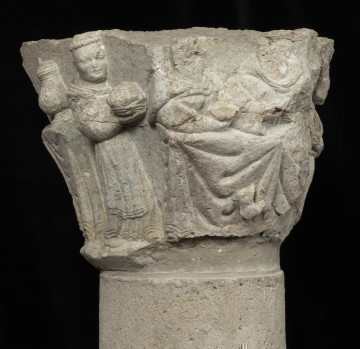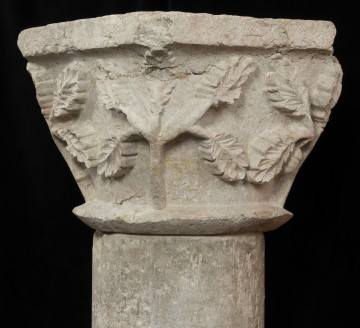
Capitol depicting meal of monks
1330 — 1340
National Museum in Szczecin
Part of the collection: Romanesque and early gothic stone capitals
A capital presenting four monks belongs to the group of architectural elements found in the area of the no longer existing buildings of the Cistercian monastery in Kołbacz. After the introduction of Reformation in Pomerania, the monastery was secularised and transformed into a ducal residence in 1535. Philipp Hainhofer, a famous Augsburg art collector related to the Szczecin court of Philip II, who stayed in 1617 in the Kołbacz residence, mentions a ducal bedroom and a column with a devil’s image, as well as a large room with a vault supported by columns with presentations of monks in his travel diary. The preserved capital probably derives from the described room which, on account of the aforementioned size, could have originally been used as the chapter house, a place where monks met. This is testified by the decorative motif. The monks are presented in their cowls (Latin: cuculla), namely outer vests with long hoods. In their hands, they are holding bands that in the Medieval art symbolise the content of writings with constructive meaning. The cowls could be worn by ordained monks during choir prayers and meetings in the chapter house. Squatting monks shown in the corners make an impression as if they were carrying the upper frame of the abacus. They perform the role of atlases, whose form and function derives from ancient architecture, symbolically referring to the mythological giant Atlas holding the heaven. The monks, users of the monastery, shown on the column supporting the vault of the chapter house, simultaneously become a part of its architecture. Such symbol makes a reference to the mystical vision of St. Bernard of Clairvaux, where the monks ˗ lapides vivi (living stones) ˗ are the building material for the Cistercian temple. The texts to which the monks are pointing refer to the observance of the Cistercian rule or more extensively to Evangelical writings. These are the fundamental sources on which the operation of the monastery relies and which guarantee its position, durability and significance.
Kinga Krasnodębska
Author / creator
Dimensions
cały obiekt: height: 46 cm, width: 53 cm
Object type
capital (architecture)
Creation time / dating
Creation / finding place
Identification number
Location / status

1330 — 1340
National Museum in Szczecin

1330 — 1340
National Museum in Szczecin

1330 — 1340
National Museum in Szczecin
DISCOVER this TOPIC
Castle Museum in Łańcut
DISCOVER this PATH
Educational path